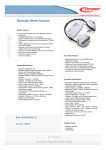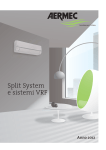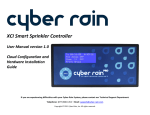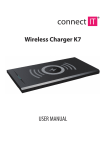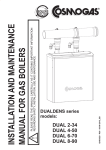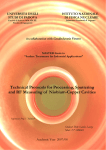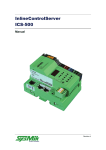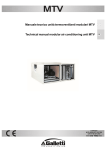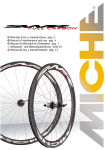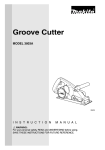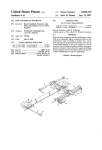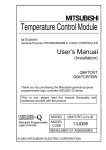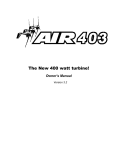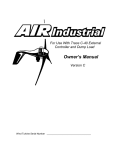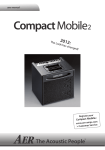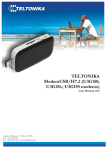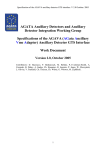Download Fans AC ACP EV RC RP VA Eng - Nordic
Transcript
Rev 00.00 AC, ACP, EV, RC, RP, VA Page 1 of 40 INSTRUCTION GUIDE FOR USE AC-ACP-EV RC-RP-VA AND MAINTENANCE ©| Aerservice S.r.l. | 2013 all rights reserved The reproduction of this manual, even partial, is strictly forbidden Rev 00.00 AC, ACP, EV, RC, RP, VA Page 2 of 40 CONTENTS Par Description 0 Analytical index of the operating and maintenance manual CONTENTS .................................................................................................................................... 2 Analytical index of the operating and maintenance manual ............................................................ 2 INTRODUCTION ............................................................................................................................ 4 Scope of the operating and maintenance manual ............................................................................. 4 Storage of the instruction manual ....................................................................................................... 5 Updating of the Instruction Manual ..................................................................................................... 5 Glossary and pictograms ..................................................................................................................... 6 GENERAL INFORMATION ......................................................................................................... 10 Manufacturer’s identification data..................................................................................................... 10 Machine identification and data plates (if they are present) .......................................................... 11 Declarations ......................................................................................................................................... 11 Guarantee activation form (with repairs by authorised centres) ................................................... 13 THE FANS .................................................................................................................................... 14 General features, applications and reference standards ............................................................... 14 THE FANS .................................................................................................................................... 15 AC series .............................................................................................................................................. 15 THE FANS .................................................................................................................................... 16 ACP series ............................................................................................................................................ 16 THE FANS .................................................................................................................................... 17 EV series ............................................................................................................................................... 17 THE FANS .................................................................................................................................... 18 RC series .............................................................................................................................................. 18 THE FANS .................................................................................................................................... 19 RP series............................................................................................................................................... 19 THE FANS .................................................................................................................................... 20 VA series............................................................................................................................................... 20 ©| Aerservice S.r.l. | 2013 all rights reserved The reproduction of this manual, even partial, is strictly forbidden AC, ACP, EV, RC, RP, VA Rev 00.00 Page 3 of 40 INSTALLATION ........................................................................................................................... 21 Positioning and installation ............................................................................................................... 21 INSTALLATION ........................................................................................................................... 23 Vibration insulation ............................................................................................................................. 23 INSTALLATION ........................................................................................................................... 24 Electrical connection .......................................................................................................................... 24 START-UP AND TESTING ......................................................................................................... 26 Start-up ................................................................................................................................................. 26 START-UP AND TESTING ......................................................................................................... 28 Testing .................................................................................................................................................. 28 ACOUSTIC INSULATION OF THE FANS ................................................................................. 29 MAINTENANCE OF THE FAN.................................................................................................... 30 Routine maintenance .......................................................................................................................... 30 MAINTENANCE OF THE FAN.................................................................................................... 32 Malfunctions ......................................................................................................................................... 32 SAFETY........................................................................................................................................ 33 Residual risks ...................................................................................................................................... 33 SAFETY........................................................................................................................................ 36 Instructions for emergency situations .............................................................................................. 36 DECOMMISSIONING .................................................................................................................. 37 Operations to decommision the system ........................................................................................... 37 Details of maintenance operations .......................................................................................... 38 ©| Aerservice S.r.l. | 2013 all rights reserved The reproduction of this manual, even partial, is strictly forbidden Rev 00.00 AC, ACP, EV, RC, RP, VA Page 4 of 40 INTRODUCTION Par Description 1 Scope of the operating and maintenance manual This instruction manual is an integral part of the machine and has the purpose of providing all the necessary information for the following purposes: • Raise the awareness of operators as regards safety matters; • Safe handling of the machine when packaged and unpackaged; • Correct installation of the machine; • Thorough knowledge of the machine’s operations and limits; • Correct use in total safety; • Correct and safe maintenance; • Dismantling of the machine in total safety, in compliance with the regulations in force on the health and safety of workers and the environment. The people in charge of the company’s departments in which this machine will be installed must, according to the regulations in force, carefully read the content of this Operating Manual and ensure that operators and maintenance staff operating and working on the machine read the relevant parts. The time dedicated to this will be fully rewarded by the correct and safe operation of the machine. This document is based on the assumption that the systems in which the machine is to be installed are in compliance with the health and safety at work regulations in force. The instructions, drawings and documentation contained in this Manual are of a technical confidential nature and are property of the manufacturer; they may not be reproduced in any way, in part of fully. If this manual is amended by the manufacturer, the Customer has the responsibility of ensuring that only the updated versions are available in the points of use. ©| Aerservice S.r.l. | 2013 all rights reserved The reproduction of this manual, even partial, is strictly forbidden AC, ACP, EV, RC, RP, VA Rev 00.00 Page 5 of 40 INTRODUCTION Par Description 2 Storage of the instruction manual The instruction manual must be kept safely and must be handed over to new owners in case of sale throughout the lifecycle of the machine. To help preserve the manual in good condition it must be handled with care and with clean hands, and it must not be placed on dirty surfaces. It is forbidden to remove, tear out or arbitrarily modify any parts of the manual. The manual must be stored in an environment away from humidity and heat, in a position near the machines to which it refers. Upon the User’s request the Manufacturer shall supply other copies of the machine’s instruction manual. INTRODUCTION Par Description 3 Updating of the Instruction Manual The manufacturer reserves the right to modify the project and improve the machine without informing customers and without updating the manual already delivered to the User. If modifications are made to a machine installed at the customer’s premises, in agreement with the manufacturer, and which entail the amendment of one or more chapters of the manual, the manufacturer shall send the amended chapters to the holders of the Instruction Manual and its new overall revision. According to the instructions that will accompany the updated documentation, the User shall replace the old chapters in the copies held with the new ones, as well as the first page and table of contents with the new revision level. The manufacturer shall be responsible for the descriptions in Italian; translations cannot be thoroughly checked therefore if there is a difference the Italian version must be considered correct; if this should occur please contact our sales office that shall make the necessary amendments. ©| Aerservice S.r.l. | 2013 all rights reserved The reproduction of this manual, even partial, is strictly forbidden AC, ACP, EV, RC, RP, VA Rev 00.00 Page 6 of 40 INTRODUCTION Par Description 4 Glossary and pictograms This paragraph lists some terms which are not commonly used or with a meaning different from the common one. The meaning of the abbreviations and pictograms used is described below. The abbreviations and pictograms are used to indicate operator qualifications and state of the machine; they provide, in a quick and univocal manner, the information necessary for the correct and safe use of the machine. GLOSSARY (Annex I point. 1.1.1 Dir. 2006/42/EC) HAZARD A potential source of injury or damage to health; DANGER ZONE Any zone within and/or around machinery in which a person is subject to a risk to his health or safety; EXPOSED PERSON Any person wholly or partially in a danger zone; OPERATOR The person or persons installing, operating, adjusting, maintaining, cleaning, repairing or moving machinery; RISK A combination of the probability and the degree of an injury or damage to health that can arise in a hazardous situation; GUARD A part of the machinery used specifically to provide protection by means of a physical barrier; PROTECTIVE DEVICE A device (other than a guard) which reduces the risk, either alone or in conjunction with a guard; INTENDED USE The use of machinery in accordance with the information provided in the instructions for use; REASONABLY FORESEEABLE MISUSE The use of the machinery in a way not intended in the instructions for use, but which may result from readily predictable human behaviour. OTHER DEFINITIONS MAN-MACHINERY INTERACTION Any situation in which the operator interacts with machinery in any of the operating phases during the lifecycle of the machinery. OPERATOR QUALIFICATIONS Minimum level of skill that an operator must have to carry out the described operation. ©| Aerservice S.r.l. | 2013 all rights reserved The reproduction of this manual, even partial, is strictly forbidden AC, ACP, EV, RC, RP, VA Rev 00.00 Page 7 of 40 NUMBER OF OPERATORS The suitable number of operators, able to carry out the operation described in an optimal way, as established by a careful manufacturer analysis, whereby a different number of operators might not make it possible to obtain the expected result or might endanger the safety of the personnel involved. STATE OF THE MACHINE The state of the machine includes operating modes, for example automatic running mode, jog command, stop, etc., the condition of the safety devices on the machines such as protection devices provided (or not provided), pressed emergency button, type of isolation from energy sources, etc. RESIDUAL RISK Risks that persist despite the adoption of the protective measures included in the design of the machine and despite the additional protective devices and measures adopted. SAFETY DEVICE Device: - That carries out a safety function; - which, when faulty and/or broken, endangers the safety of people. (e.g. lifting equipment; fixed, mobile, adjustable protective device, etc., electric, electronic, optical, pneumatic, hydraulic device interlocking a protection device, etc.). PICTOGRAMS The descriptions that follow this pictogram contain: very important information/instructions, in particular as regards safety. Failure to respect them may lead to: • danger for the safety of the operators; • loss of contractual guarantee; • waiver of the manufacturer’s liabilities. PICTOGRAMS CONCERNING OPERATOR QUALIFICATIONS Symbol Description Unskilled worker: operator without specific skills that can only carry out simple tasks following the instructions of qualified technicians. Driver of lifting and handling means: operator qualified to use machines and material handling and lifting equipment (strictly following the manufacturer’s instructions), according to the laws in force in the country of use of the machine. Mechanical service man: a qualified technician that can manage the machine in normal conditions, operate in jog mode with the protection devices disabled and work on its mechanical parts to make the necessary adjustments, repairs and maintenance. Usually he is not qualified to work on live electrical systems. Electrical service man: a qualified technician that can use the machine in normal conditions, operate in jog mode with the protection devices disabled and work on electrical parts to make the necessary adjustments, repairs and maintenance. He can work on live cabinets and junction boxes. Manufacturer’s technician: qualified technician provided by the manufacturer to carry out complex operations in particular situations, or in any case as agreed with the user. According to the situation the technician will have mechanical and/or electrical and/or electronic and/or software skills. ©| Aerservice S.r.l. | 2013 all rights reserved The reproduction of this manual, even partial, is strictly forbidden Rev 00.00 AC, ACP, EV, RC, RP, VA Page 8 of 40 Tab. 0 - 4.1 PICTOGRAMS CONCERNING THE STATE OF THE MACHINE Pictograms inside a square/rectangle provide INFORMATION. Symbol Description Machine off: with hydraulic or electric power supply disconnected. Machine on: with hydraulic or electric power supply connected and in safe stop condition with open mobile protective devices (specifying which); JOG disabled; fixed protection devices closed. Machine on: with hydraulic or electric power supply connected and in safe stop condition with emergency mushroom button pressed or other control with the same function activated, positioned near the intervention area (specifying the mushroom button or the device to be used). Machine moving: in automatic mode, with mobile protection devices closed, the relevant interlocking devices activated, and the fixed protection devices closed. Machine moving: in JOG mode, with mobile protection devices closed, the relevant interlocking devices activated, and the fixed protection devices closed. Machine moving: in JOG mode, with one or more mobile protection devices, that can be disabled, open (specifying which) with the relevant interlocking devices activated and fixed protection devices closed. Machine on: in stand-by and waiting for functional consent to start (e.g. presence of product), mobile protection devices closed with safety device closed, and fixed protection devices closed. Tab. 0 - 4.2 ©| Aerservice S.r.l. | 2013 all rights reserved The reproduction of this manual, even partial, is strictly forbidden Rev 00.00 AC, ACP, EV, RC, RP, VA Page 9 of 40 SAFETY SIGNS • • The pictograms inside a triangle indicate DANGER; The pictograms inside a circle mean PROHIBITION/OBLIGATION. Symbol Description Dangerous electrical voltage Danger of crushing of upper limbs Danger of entanglement Danger of being dragged by machine parts General hazard Danger of entanglement in transmission belt Hot surfaces; danger of burning Danger of being dragged by impellers or rotating parts No access to unauthorised people Do not remove safety devices Do not manually clean, oil, grease, repair of adjust moving parts Do not carry out any work without disconnecting the power Protective gloves must be worn Safety footwear must be worn Safety helmets must be worn Tab. 0 - 4.3 ©| Aerservice S.r.l. | 2013 all rights reserved The reproduction of this manual, even partial, is strictly forbidden AC, ACP, EV, RC, RP, VA Rev 00.00 Page 10 of 40 GENERAL INFORMATION Par Description 1 Manufacturer’s identification data MANUFACTURER Aerservice S.r.l. REGISTERED OFFICE – ADMINISTRATIVE OFFICE Via Marconi, 1 Z.I. – 35020 – Legnaro – (PD) – Italy AFTER SALES/SPARE PARTS SERVICE Tel. +39 049 641 200 Fax. +39 049 825 2310 E-mail: [email protected] CALL CENTER Tel. +39 049 641 200 CONTACTS Tel. +39 049 641 200 Fax. +39 049 825 2310 E-mail: • [email protected] ©| Aerservice S.r.l. | 2013 all rights reserved The reproduction of this manual, even partial, is strictly forbidden Rev 00.00 AC, ACP, EV, RC, RP, VA Page 11 of 40 GENERAL INFORMATION Par Description 2 Machine identification and data plates (if they are present) Each machine is fitted with a CE plate with indelible identification data. All communications with the manufacturer or technical assistance centres must refer to the said data. Year of manufacture Article code Article barcode Serial number Revision number of label Serial number barcode The position of the plate on the machine may vary. GENERAL INFORMATION Par Description 3 Declarations The machine is manufactured in conformity with relevant EC Directives, applicable when the machine is put on the market. ANNEX IV Directive 2006/42/EC The machine does not belong to the category of machines mentioned in Annex IV to directive 2006/42/EC ©| Aerservice S.r.l. | 2013 all rights reserved The reproduction of this manual, even partial, is strictly forbidden Rev 00.00 AC, ACP, EV, RC, RP, VA Page 12 of 40 EC DECLARATION OF CONFORMITY (Annex IIA DIR. 2006/42/CE) THE MANUFACTURER Aerservice S.r.l. Company Via Marconi, 1 Z.I. 35020 Padua Address Zip code Province Legnaro Italy City Country DECLARES THAT THE MACHINE Single inlet centrifugal fans AC, ACP, EV, RC, RP, VA Description Model _ _-_ _ _ _ _ _-_ _ _ _ ____ Serial number Year of manufacture AC, ACP, EV, RC, RP, VA Commercial name Single inlet centrifugal fans for extraction plants Intended use IS IN COMPLIANCE WITH THE FOLLOWING DIRECTIVES Directive 2006/42/EC of the European Parliament and Council of 17 may 2006 on machinery and amending directive 95/16/EC. Directive 2004/10/8/EC of the European Parliament and Council of 15 December 2004 on the approximation of the laws of the member States relating to electromagnetic compatibility. Directive 2006/95/EC of the European Parliament and Council of 12 December 2006 on the approximation of the laws of Member States relating to electrical equipment designed for use within certain voltage limits. Reference to harmonised standards: EN 349:1993+A1:2008, EN 614-1:2006+A1:2009, EN 614-2:2000+A1:2008, EN 626-1:1994+A1:2008, EN 626-2:1996+A1:2008, EN 842:1996+A1:2008, EN 894-1:1997+A1:2008, EN 894-2:1997+A1:2008, EN 894-3:2000+A1:2008, EN 953:1997+A1:2009, EN 10052:2003+A1:2008, EN 1037:1995+A1:2008, EN 1037:1995+A1:2008, EN 1093-1:2008, EN 1093-4:1996+A1:2008, EN 13478:2001+A1:2008, EN ISO 138491:2008, EN ISO 13849-2:2008, EN ISO 13850:2008, EN ISO 13857:2008, EN ISO 14121-1:2007, EN ISO 14159:2008 AND DECLARES THAT THE TECHNICAL FILE Has been compiled by the manufacturer and is kept at: Aerservice S.r.l. in Via Marconi,1 Z.I. – 35020 – Legnaro – PD – Italy Place and date of document The manufacturer Legnaro, _ _ / _ _ / _ _ _ _ Legal representative D.C.: DC N-001/00001 ©| Aerservice S.r.l. | 2013 all rights reserved The reproduction of this manual, even partial, is strictly forbidden Rev 00.00 AC, ACP, EV, RC, RP, VA Page 13 of 40 GENERAL INFORMATION Par Description 4 Guarantee activation form (with repairs by authorized centers) BUYER’S DETAILS: COMPANY NAME ▼ _______________________________ Section to be filled in and returned in a sealed envelope to: Aerservice S.r.l. Via Marconi, 1 Z.I. 35020 Legnaro (PD) Italy BUSINESS/PROFESSION/DEPARTMENT ▼ _______________________________ USER DATA (Surname and Name) ▼ _______________________________ PLACE OF INSTALLATION ADDRESS ▼ _______________________________ ZIP CODE ▼ _________ _________ Telephone ▼ _________ _________ Please enclose also a copy of the purchase document (delivery note, invoice, receipt) showing the date of purchase. Or send a fax to +39 049 825 2310 . CITY ▼ Fax ▼ e-mail ▼ _________ Purchase date ▼ _________ Model ▼ _________ Serial number ▼ _________ accessory/ies ▼ _________ In accordance with article 10 of Law 675/96 data provided in this form shall be recorded on protected electronic supports and shall be treated using computerised systems; data must be provided in order to enter into and execute the contractual relationship established by the Guarantee. Data may be used by Aerservice and by specialised companies operating in Italy and abroad on behalf of Aerservice S.r.l., for customer communications. Pursuant to article 13 of Law 675/96, you may, at any time and free of charge, check the data held and obtain the rectification or erasure of the data; you also have the right to object in full or in part to the use of the data for the purposes described above, by writing to Aerservice S.r.l. – via Marconi 1 – 35020 Legnaro (PD), Italy , for the attention of the Data Controller. Check this box if you do not consent to the use of the data provided for purposes other than the management of the Guarantee By providing Aerservice S.r.l. with personal data you have the right to a further six months GUARANTEE following on from the twelve month normally guaranteed ⃞ Customer’s Signature_____________ 12 MONTH GUARANTEE ACTIVATION REQUEST FORM This GUARANTEE gives the right to telephone assistance and to interventions by qualified Aerservice personnel to restore the equipment following problems caused by manufacturing faults; this guarantee is valid for 12 months from the date of purchase. The guarantee does not cover any damage to the outer enclosures or faults caused by natural events (lightening, flooding, etc), intent, improper use or use of incompatible consumables. The Guarantee does not cover consumable parts such as filters, flexible hose, lamps, etc. Any assistance carried out by unauthorised personnel shall invalidate the guarantee, By providing Aerservice S.r.l. with personal data you have the right to a further six months GUARANTEE following on from the twelve month normally guaranteed To benefit from the Guarantee please fill in the upper section of this card and send it in a sealed envelope, within 10 days from the date of purchase of the equipment, to the following address: Aerservice S.r.l - Via Marconi, 1 Z.I. - 35020 Legnaro (PD) Italy. Please attach a copy of the purchase document, or send all documents via fax to +39 049 825 2310 , or to the website www.aerservice.it. Keep this section of the card together with the original purchase document to certify your right to the Guarantee. For telephone support or technical assistance please call: +39 049 641 200 ©| Aerservice S.r.l. | 2013 all rights reserved The reproduction of this manual, even partial, is strictly forbidden AC, ACP, EV, RC, RP, VA Rev 00.00 Page 14 of 40 THE FANS Par Description 1 General features, applications and reference standards General features and applications The AC, ACP, EV, RC, RP, VA are centrifugal, single inlet fans and are made as follows: - AC series with forward curved blades, ACP series of polypropylene, EV series with forward curved blades, RC series withbackward curved baldes, RP series withbackward flat baldes, VA series with radial blades. They are normally used in the extraction systems, their implementation allow to use them in various sectors such as: - in the civilian one: to ensure the correct exchange of fresh air in for catering: such as in canteens, restaurants, fast food, for the extraction of vapors and odors as well as the heat produced in the kitchens; for fire systems: for the forced evacuation of smoke and heat; industry: for the extraction of welding fumes, dusty fluids with temperatures up to 80° C and, for special versions and working environments subjected to ATEX special versions; for the automotive industry: for the suction of the exhaust gases of motor vehicles in the tests of workshop REFERENCE STANDARDS UNI EN 1032:1998 2006/42 CE 2004/108/CE 2006/95 CE D.L. 81/2008 UNI EN 12101-3:2004 94/9/CE ATEX UNI EN 13779:2008 UNE 100165:2004 UNI EN 13141-9 UNI EN 15251:2008 ©| Aerservice S.r.l. | 2013 all rights reserved Mechanical vibrations - Testing of mobile machinery in order to determine the extent of whole-body vibration transmission– General features Safety of machinery and subsequent additions CE Electromagnetic Compatibility Low voltage Improvement of safety and health in the workplace Control systems for smoke and heat - Specification for powered smoke and heat exhaust ventilators For equipment and protective systems intended for use in potentially explosive atmospheres Ventilation for non-residential buildings. Performance requirements for ventilation and airconditioning of fencing. Air conditioning. The smoke extraction and ventilation of kitchens Ventilation for buildings - Performance evaluation of components / products for residential ventilation Ventilation for buildings - Fire Fighting Measures for air distribution systems in buildings. The reproduction of this manual, even partial, is strictly forbidden AC, ACP, EV, RC, RP, VA Rev 00.00 Page 15 of 40 THE FANS Par Description 2 AC series The series identifies AC centrifugal fans with forward curved blades of steel, are used in industry, catering, ventilation in rooms used as toilets and, in their own special version, even in locations subject to ATEX. TECHNICAL SPECIFICATIONS RANGE OF USE Airflow Pressure MIN.DIAM.OF IMPELLER MAX.DIAM.OF IMPELLER MOTOR Volt [±10%] Poles IP MIN. LIMIT FLUID TEMP. MAX. LIMIT FLUID TEMP. m3/h Pa mm mm da 540 a 19000 da 270 a 2000 200 500 230 M / 230-400 T / 400-690 T 2-4-6 55 °C -10 °C +40 STRUCTURE The structure of the fan is made entirely of welded steel plate of suitable thickness and then powder coated in RAL 7032. In addition to the chair support for the electric motor and can request a further chair fixed to the suction mouth to increase the solidity of the machine. IMPELLERS We use impellers with forward curved blades made of galvanized sheet steel and welded statically and dynamically balanced according to ISO keeping to the minimum noise and vibrations. MOTORS Of nation-building, three-phase asynchronous squirrel-cage, running 400V/50-60 Hz, B3 case, IP55 protection, according to the standards UNELMEC. Installed at 2, 4 or 6 depending on the Pressure Poles request, or double polarity for the two-speed versions. The assembly is provided on a chair support foundation common to the fan. The outputs stated in the performance tables have been dimensioned taking into account the performance of the machine and an additional margin of safety to compensate for any faults in the system. SPECIAL ATEX VERSIONS: Environments with risk of explosion regulated by 94/9/CE legislation. ©| Aerservice S.r.l. | 2013 all rights reserved The reproduction of this manual, even partial, is strictly forbidden AC, ACP, EV, RC, RP, VA Rev 00.00 Page 16 of 40 THE FANS Par Description 3 ACP series The series ACP identifies centrifugal fans made entirely polypropylene, with forward curved blades, which are used in the chemical industry, in the hospital and in their special version, also in locations subject to ATEX regulation. TECHNICAL SPECIFICATIOS RANGE OF USE Airflow Pressure MIN.DIAM.OF IMPELLER MAX.DIAM.OF IMPELLER MOTOR Volt [±10%] Poles IP MIN. LIMIT FLUID TEMP. MAX. LIMIT FLUID TEMP. m3/h Pa mm mm from 100 to 10000 from 20 to 1000 140 420 230 M / 230-400 T / 400-690 T 2-4-6 55 °C -10 °C +40 STRUCTURE The structure of the fan is entirely made of injectionmolded polypropylene that makes it completely corrosion. Special seal materials are corrosion on the fan are a guarantee against the risk of leakage of harmful gases. IMPELLERS They are used impellers with forward curved blades made of polypropylene, statically and dynamically balanced according to ISO standards securing a perfect balance, low noise and resistance, quality assurance and long operation. MOTORS Of nation-building, three-phase asynchronous squirrel-cage, running 400V/50-60 Hz, B3 case, IP55 protection, according to the standards UNELMEC. Installed at 2, 4 or 6 Poles depending on the Pressure request, or double polarity for the two-speed versions. The assembly is provided on a chair support of the foundation to the common fan. The outputs stated in the performance tables have been dimensioned taking into account the performance of the machine and an additional margin of safety to compensate for any faults in the system. SPECIAL ATEX VERSIONS: Environments with risk of explosion regulated by 94/9/CE legislation. ©| Aerservice S.r.l. | 2013 all rights reserved The reproduction of this manual, even partial, is strictly forbidden AC, ACP, EV, RC, RP, VA Rev 00.00 Page 17 of 40 THE FANS Par Description 4 EV series The EV series identifies centrifugal fans in steel, with forward curved blades, which are used in industry, ventilation and local garage for the toilets and hospital sector, in their special versions also in locations subject to ATEX. TECHNICAL SPECIFICATIOS RANGE OF USE Airflow Pressure MIN.DIAM.OF IMPELLER MAX.DIAM.OF IMPELLER MOTOR Volt [±10%] Poles IP MIN. LIMIT FLUID TEMP. MAX. LIMIT FLUID TEMP. m3/h Pa mm mm from 200 to 3000 from 320 to 1800 130 250 230 M / 230-400 T / 400-690 T 2 55 °C -10 °C +40 STRUCTURE The structure of the fan is made entirely of welded steel plate of suitable thickness and then powder coated in black RAL 9005. In the standard version the fan is in B5 version you can ask a chair to install it B3 version. IMPELLERS We use impellers with forward curved blades made of galvanized sheet steel and welded statically and dynamically balanced according to ISO keeping to the minimum noise and vibrations. MOTORS Of nation-building, three-phase asynchronous squirrel-cage, running 400V/50-60 Hz, cash B5, IP55 protection, according to the standards UNELMEC. Installed 2-pole. The assembly is provided on a chair support of the foundation to the common fan. The outputs stated in the performance tables have been dimensioned taking into account the performance of the machine and an additional margin of safety to compensate for any faults in the system. SPECIAL ATEX VERSIONS: Environments with risk of explosion regulated by 94/9/CE legislation. ©| Aerservice S.r.l. | 2013 all rights reserved The reproduction of this manual, even partial, is strictly forbidden AC, ACP, EV, RC, RP, VA Rev 00.00 Page 18 of 40 THE FANS Par Description 5 RC series The series RC identifies steel fans with backward curved blades, which are used in industry, hospitals, catering, and in their special versions also in locations subject to ATEX. TECHNICAL SPECIFICATIOS RANGE OF USE Airflow Pressure MIN.DIAM.OF IMPELLER MAX.DIAM.OF IMPELLER MOTOR Volt [±10%] Poles IP MIN. LIMIT FLUID TEMP. MAX. LIMIT FLUID TEMP. m3/h Pa mm mm from 470 to 17000 from 410 to 5610 250 630 230 M / 230-400 T / 400-690 T 2-4 55 °C -10 °C +40 STRUCTURE The structure of the fan is made entirely of welded steel plate of suitable thickness and then powder coated in RAL 7032. In addition to the chair support for the electric motor and can request a further chair fixed on the inlet to increase the robustness of the machine. IMPELLERS We use backward curved impellers made of sheet steel thick welded and painted with epoxy powders, statically and dynamically balanced according to ISO keeping to a minimum noise and vibration. MOTORS Of nation-building, three-phase asynchronous squirrel-cage, running 400V/50-60 Hz, B3 case, IP55 protection, according to the standards UNELMEC. Installed at 2, 4 or 6 Poles depending on the Pressure request, or double polarity for the two-speed versions. The assembly is provided on a chair support of the foundation to the common fan. The outputs stated in the performance tables have been dimensioned taking into account the performance of the machine and an additional margin of safety to compensate for any faults in the system. SPECIAL ATEX VERSIONS: Environments with risk of explosion regulated by 94/9/CE legislation. ©| Aerservice S.r.l. | 2013 all rights reserved The reproduction of this manual, even partial, is strictly forbidden AC, ACP, EV, RC, RP, VA Rev 00.00 Page 19 of 40 THE FANS Par Description 6 RP series The series RP identifies steel fans with backward plan blades, which are used in industry, hospitals, catering, and in their special versions also in locations subject to ATEX. TECHNICAL SPECIFICATIOS RANGE OF USE Airflow Pressure MIN.DIAM.OF IMPELLER MAX.DIAM.OF IMPELLER MOTOR Volt [±10%] Poles IP MIN. LIMIT FLUID TEMP. MAX. LIMIT FLUID TEMP. m3/h Pa mm mm from 930 to 24200 from 380 to 3700 250 630 230 M / 230-400 T / 400-690 T 2-4-6 55 °C -10 °C +40 STRUCTURE The structure of the fan is made entirely of welded steel plate of suitable thickness and then powder coated in RAL 7032. In addition to the chair support for the electric motor and can request a further chair fixed on the inlet to increase the strength of the machine. IMPELLERS We use backward planimpellers made of sheet steel thick welded and painted with epoxy powders, statically and dynamically balanced according to ISO keeping to a minimum noise and vibration. MOTORS The structure of the fan is made entirely of welded steel plate of suitable thickness and then powder coated in RAL 7032. In addition to the chair support for the electric motor and can request a further chair fixed on the inlet to increase the strength of macchinDi nation-building, three-phase asynchronous squirrel-cage, running 400V/50-60 Hz, B3 case, protection IP55 according UNELMEC standards. Installed at 2, 4 or 6 Poles depending on the Pressure request, or double polarity for the two-speed versions. The assembly is provided on a chair support of the foundation to the common fan. The outputs stated in the performance tables have been dimensioned taking into account the performance of the machine and an additional margin of safety to compensate for any faults in the system. SPECIAL ATEX VERSIONS: Environments with risk of explosion regulated by 94/9/CE legislation. ©| Aerservice S.r.l. | 2013 all rights reserved The reproduction of this manual, even partial, is strictly forbidden AC, ACP, EV, RC, RP, VA Rev 00.00 Page 20 of 40 THE FANS Par Description 7 VA series The VA series identifies fans die-cast aluminum, with steel impeller with radial blades, which are used in industry, ventilation of the garage, and in their special versions also in locations subject to ATEX. TECHNICAL SPECIFICATIOS RANGE OF USE Airflow Pressure MIN.DIAM.OF IMPELLER MAX.DIAM.OF IMPELLER MOTOR Volt [±10%] Poles IP MIN. LIMIT FLUID TEMP. MAX. LIMIT FLUID TEMP. m3/h Pa mm mm from 200 to 1500 from 550 to 3000 250 400 230 M / 230-400 T / 400-690 T 2 55 °C -10 °C +40 STRUCTURE The structure of the fan is entirely made of die-cast aluminum and then powder coated in red RAL 3000. With these features the electric assumes a remarkable lightness and also a high resistance to any chemical agents present in the fluid. IMPELLERS We use impellers with radial blades made of welded steel sheet painted with epoxy powders and statically and dynamically balanced according to ISO keeping noise to a minimum and vibration. MOTORS Of nation-building, three-phase asynchronous squirrel-cage, running 400V/50-60 Hz, B3 case, IP55 protection, according to the standards UNELMEC. Installed 2 Poles. The assembly is provided on a chair support of the foundation to the common fan. The outputs stated in the performance tables have been dimensioned taking into account the performance of the machine and an additional margin of safety to compensate for any faults in the system. It 'made of painted steel blades, welded to the impeller, are in heavy gauge steel, making it suitable for the transport of very dusty air. SPECIAL ATEX VERSIONS: Environments with risk of explosion regulated by 94/9/CE legislation. ©| Aerservice S.r.l. | 2013 all rights reserved The reproduction of this manual, even partial, is strictly forbidden Rev 00.00 AC, ACP, EV, RC, RP, VA Page 21 of 40 INSTALLATION Par Description 1 Positioning and installation The unit installation area must allow for easy access for inspection, maintenance and replacement part operations. Installation must be carried out: Directly on the floor On a steel base frame On a concrete base On a hanging base Flooring and bases must be able to properly support the appliances and respect safety and machine mass requirements. ©| Aerservice S.r.l. | 2013 all rights reserved The reproduction of this manual, even partial, is strictly forbidden AC, ACP, EV, RC, RP, VA Rev 00.00 Page 22 of 40 For safety purposes, it is essential to verify the following before installation: • That the position of installation will not create any danger to the user or any personnel present in the area • The installation area must allow for easy access for inspection, maintenance and replacement part operations. • Verify that the wall or other support systems offer proper support characteristics in accordance with safety and machine mass requirements. • Before starting any drilling operations (necessary for installation), it is necessary to verify that the structure to be drilled are not supporting structures. If they are (for example if they are beams or pillars), consult with the system designer before carrying out any drilling. • To guarantee proper fan functioning, it is essential to always set distances. For example, 1.5 times the diameter of the fan wheel as a distance between a free air flow suction wall (image 1), or 2.5 times the diameter of the fan wheel as a distance from the first bend of the fan air flow (image 2). The same goes for upstream or suction piping, as a good rule for bends is to maintain a minimum range of internal curving which is equal to the tube diameter. During the assembly phase, operators can adjust fan direction on some types of fans. Centrifugal fan construction is characterised by the position of its outlet vent. Each outlet vent position corresponds to two suction vent positions. The construction forms vary by 45° to 45°. AERSERVICE reserves the right to modify data without notice. Since appliance conditions are beyond manufacturer control, AERSERVICE is not liable for any danger caused by improper use of these products. ©| Aerservice S.r.l. | 2013 all rights reserved The reproduction of this manual, even partial, is strictly forbidden AC, ACP, EV, RC, RP, VA Rev 00.00 Page 23 of 40 INSTALLATION Par Description 2 Vibration insulation Vibration insulation material must be placed between the fan and the object onto which it is to be fastened. Avoid fastening directly with bolts, used special machine stops instead. To prevent vibrations from being transmitted along the suction ducting, insert an anti-vibrating joint between the connection cone between the fan and the ducting / control damper. Also in the case of hanging installations, AerService suggests not screwing appliance support brackets directly to the ceiling but always setting proper vibration insulation material in between. If anti-vibration spring supports or rigid rubber supports are required for further insulation between the fan base and the support surface, supply hydraulic attachments and proper joints. Aerservice supplies the Vibrostop Kit on request. ©| Aerservice S.r.l. | 2013 all rights reserved The reproduction of this manual, even partial, is strictly forbidden AC, ACP, EV, RC, RP, VA Rev 00.00 Page 24 of 40 INSTALLATION Par Description 3 Electrical connection • • • • Before proceeding, verify that personnel has read and understood the user and installation manual. Carefully check before starting machine that the power network is adequate for motors as indicated on the respective ID plates. Inspect the motor power electrical control panel to verify that the safeguarding protections have been sized for maximum amperage according to the respective ID plates. If protection parts are sized for a slightly higher amperage than that stated on the ID plate, make sure that the working range is adequate. The most simple start-up system for an electric motor is obtained by direct connection to the mains power supply. This however creates some limitations caused by elevated starting current (breakaway starting current). This type of direct starting is therefore recommended only for voltage of up to 5.5 kW, voltages which AerService installs on 4-pole, 230 / 400 V, three phase motors. If the motor starting current exceeds that which is allowed by the mains power supply, opting for connection with Y insertion / delta insertion. Connection examples are illustrated in the following diagrams: DELTA CONNECTION Y CONNECTION CONNECTION FOR TWO-SPEED MOTORS IS INSTEAD AS FOLLOWS. TO PERFORM DIRECT ELECTRIC MOTOR STARTING UP CONNECTION. LOW SPEED ©| Aerservice S.r.l. | 2013 all rights reserved HIGH SPEED The reproduction of this manual, even partial, is strictly forbidden AC, ACP, EV, RC, RP, VA Rev 00.00 Page 25 of 40 BELOW A DIAGRAM WITH DIRECTIONS ON HOW TO PERFORM DIRECT ELECTRIC MOTOR STARTING UP CONNECTION: KEY: IG: IMT: LS1: M: FG: MAIN SWITCH OVERLOAD CUT-OUT NETWORK SIGNAL LAMP FAN MOTOR MAIN FUSES Aeraulic connection At the end of aeraulic suction and output connections, verify that said connections are airtight, both in the main sections and in branches, over all points of use. Connections which are not sufficiently watertight can cause aeraulic leaks and therefore compromise proper system functioning. NOTE FOR ELEVATED FLOW AND ROTATIONS HIGHER THAN 1400 RPMS, INSERTION OF A BUTTERFLY OR GUILLOTINE CALIBRATION DAMPER IS RECOMMENDED. THIS ALLOWS FOR SUCTION FLOW REGULATION AND ALLOWS PROPER ELECTRICAL ABSORPTION BY THE MOTOR (NOT TO EXCEED DATA SHOWN ON ID PLATE). SEE FAN STARTING UP. ©| Aerservice S.r.l. | 2013 all rights reserved The reproduction of this manual, even partial, is strictly forbidden AC, ACP, EV, RC, RP, VA Rev 00.00 Page 26 of 40 START-UP AND TESTING Par Description 1 Start-up Before proceeding with start-up, carry out the following control operations: • Verify fan wheel function by turning it • Verify that shock absorbers are free from any safety stops installed to prevent damage during transport. • Verify motor and fan bearing lubrification. • Verify that all fasteners have been properly tightened, paying particular attention to support, base, pulley and transmission, motor and fan wheel joints. • Verify that there are no foreign bodies inside the fan. • Verify manually that the fan wheel does not rub against walls. • Verify that the inspection door (where present) is closed. • Provide proper protection nets or grilles for any unchanneled vents. • Check earthing connections. • Verify that all dampers or flow regulators are in the open position for helical fans, closed for centrifugal fans. During the start-up phase, said operations prevent dangerous motor overloading ©| Aerservice S.r.l. | 2013 all rights reserved The reproduction of this manual, even partial, is strictly forbidden Rev 00.00 AC, ACP, EV, RC, RP, VA • Start up the motor and verify that the rotation direction complies with that shown on the ID plate (invert the two phases if necessary on the terminal board). • Measure electrical motor absorption and compare with data indicated on the ID plate of the motor itself. Page 27 of 40 Reccomendations: • Aerservice recommends: when verifying motor amperometric absorption, it is important to make sure that the level is not lower than the level declared on the ID plate. We therefore recommend inserting an overload cut-out calibrated at a slightly lower level than the absorption indicated on the ID plate. • Aerservice recommends: to get around the problem of elevated absorption on the electrical motor, utilise instruments calibrated properly as to influence motor absorption. • Control damper: The control damper allows air flow to be regulated and therefore also pressure, reducing the passage of air given flow and pressure reduce fan absorption. • Inverter: The inverter is an instrument which acts directly on the fan motor; in fact, it supplies power. Calibrating the inverter accurately, it is possible to manage motor performance and related absorption. ©| Aerservice S.r.l. | 2013 all rights reserved The reproduction of this manual, even partial, is strictly forbidden Rev 00.00 AC, ACP, EV, RC, RP, VA Page 28 of 40 START-UP AND TESTING Par Description 2 Testing The external air inlet and outlets must be completely free crossover passages. If fans remain for an extended period of time at a work site, it is best before inspection to make sure that these passageways are not clogged with foreign bodies or that the control dampers are not in a totally or partial closed position. AerService provides special "antirain caps" equipped with special anti-leaf micro-pressing net fabric of 10 mm x 1mm for external installation. It is always best however to verify that the air flows are not clogged in any way. In the same way, it is best to verify inside aeraulic distribution circuits that there are no calibration dampers in a closed position and that any safety systems such as fire dampers or smoke dampers have not been triggered and therefore are obstructing air flow. The power and control electrical panels must be regularly powered at a normal operating voltage. Whenever environmental or weather conditions differ from those considered in design, special corrections will have to be considered as to give reliable results in the inspection phase. To verify flow, proceed as follows: • Use a gauge (oil or water, analogue or digital gauge) to measure the loss of flow for various filtering sections and therefore their fouling factor. Based on the working curve of the filters and the operating life considered during design, the treated air flow can be determined quite precisely. To carry out this verification, first obtain the upstream pressure plugs and the downstream filtering section. • Compare the flow level obtained with that acquired with the following formula: Q = 3600 x S x V with Q = air flow in m3/h, V = speed in m/s, S = flow surface in m2. The level of speed V is determined with a hot wire anemometer or “suction cup”. Subtract air lost due to the presence of conveyor guides from the front surface of the grilles or vents to consider the net flow section. The area occupied by these guides is deductible from the technical specifications and, on average, is equal to approximately 15% of the total area. To measure performed speeds with a hot-air anemometer, it is necessary to create adequate diameter slits in the channels to permit the telescopic probe to enter. Choose straight channel sections with lengths of at least 2.5 equivalent diameters or at least with the largest possible distance between obstacles or points of probable turbulence. Whenever using a suction anemometer instead, take different speed measurements on the external air inlets, or in correspondence with the suction grilles or output vents. Measurements taken with a suction anemometer are recommended whenever measuring max 2 or 3 intake grilles to prevent an erred measurement sum which could lead to an unacceptable flow rate calculation. When measuring 4 or more output diffusion vents, detection reliability is compromised and may only be useful as a general reference point to verify more precise measurements taken at one or two suction positions. Current flow measuring of the single blower fan groups during working conditions is to be carried out on power contactors inside the control panel by means of amperometric pliers. It is essential to avoid measuring directly on the motor terminal board as this is possible only with the inspection door open and consequential modifications of the length of the aeraulic circuit and therefore the operating points of the fans. As seen in the diagram, the flow level can be detected from the meeting point between the power bends and the RPM number. ©| Aerservice S.r.l. | 2013 all rights reserved The reproduction of this manual, even partial, is strictly forbidden Rev 00.00 AC, ACP, EV, RC, RP, VA Page 29 of 40 ACOUSTIC INSULATION OF THE FANS The insulated cabins of the BLU series are useful to cut down noise levels from the system where necessary. Coupling these with output and input mufflers guarantee elevated noise reduction. The aluminium support structure and pre-coated sandwich panels with a thickness of 25 mm offer robust resistance to external agents. Generally, acoustic insulation boxes are provided when excessive noise problems have been noted. It is for this reason that, when installing the fan on the external part of a building, it is very important to pay careful attention to surrounding buildings or persons which could be disturbed by noise: houses, offices, streets, shops, etc. Norms regarding noise pollution are very restrictive and very clear. It is therefore essential to avoid installing appliances near any possible receptors. Attention regarding noise levels shall not be underestimated; even when considering working environments which are normally quiet, inserting a non-insulated fan could create major disturbances. 1. LOCATE THE ELECTRICAL PANEL AND SWITCH OFF POWER TO ENSURE BOX SAFETY. 2. VERIFY THAT THE FAN WHEEL HAS STOPPED. 3. LOCATE THE INSPECTION PANEL ON THE SOUNDPROOF CABIN. 4. USING A SCREWDRIVER AS A NORMAL KEY FOR OPENING LOCKS, OPEN THE OPENING/CLOSING BLOCK. 5. ONCE ALL BLOCKS HAVE BEEN OPENED VIA THEIR HANDLES FASTENED ON THE PANEL, PULL OUTWARD TO OPEN THE PANEL. ©| Aerservice S.r.l. | 2013 all rights reserved The reproduction of this manual, even partial, is strictly forbidden AC, ACP, EV, RC, RP, VA Rev 00.00 Page 30 of 40 MAINTENANCE OF THE FAN Par Description 1 Routine maintenance AerService suggest that the Client carry out preventative maintenance on fans to maintain efficiency over time. These machines require reduced maintenance and have been designed to make each operation as easy and safe as possible. It is therefore essential to carry out routine controls: SERVICES are mainly cleaning operations, INSPECTIONS include controls on appliance condition and function. Keep track of appliance controls in a machine booklet in order to properly pace different interventions and to facilitate any failure research (see Routine Maintenance) In said book, write the date, type of servicing performed (autonomous maintenance, inspection or repair), a description of the intervention, measurements taken, etc. COMPLETELY SWITCH OFF ANY ELECTRICAL POWER TO THE APPLIANCE AND VERIFY THAT NO PERSONS SWITCH IT BACK ON BEFORE ANY MAINTENANCE OR CLEANING OPERATIONS. ON BOARD FAN SAFETY SWITCHES CAN BE PROVIDED TO FURTHER ENSURE THAT NO POWER IS SWITCHED ON. FAN For maximised fan operating conditions on the fan, check the following monthly: • cleanliness of the auger and fan wheel, removing any material deposits. All incrustation must be removed to prevent fan wheel unbalance and any possible malfunctions, noise or irreversible damage. • damage or corrosion on various parts. • fan section part fasteners. • • the hold of anti-vibration joints on the fan output vent. absence of unusual noise caused by bearing deterioration. • alignment between any pulleys has remained correct, or else correct alignment. • proper bearing lubrification (see related section). ©| Aerservice S.r.l. | 2013 all rights reserved The reproduction of this manual, even partial, is strictly forbidden AC, ACP, EV, RC, RP, VA Rev 00.00 Page 31 of 40 MOTOR Recommended verifications: • cleanliness, remove any deposits • absence of unusual noise caused by bearing deterioration BEARING LUBRIFICATION Any servicing on bearings must be carried out with proper instruments. An efficient verification of the condition of the bearings can be carried out by simply listening to the noise they generate. A bearing in good condition emits a uniform noise. Any defects cause a stronger and / or irregular sound. Bearings can however generate a slight "metallic" noise ("ticking"), mainly when at low speed. This noise is normal as it is caused by the clearance on both parts. Excessive vibrations and temperatures also indicate possible damage. Periodically check that the supports and ring blocking system inside the shaft are in good condition. Check that there has been no excessive grease loss. The duration of grease contained in the bearings may be inferior to its mechanical duration. It is therefore essential to verify grease quantity and condition. The correct moment for re-lubrification depends on several factors. Some of these include the type and dimension of the bearings, their rotating speed, the working temperature, the type of grease and the environment in which they are used. Therefore, it is only possible to give indications based on statistical data. Tf re-lubrification intervals (interval of time in which 99% of bearings are still lubricated reliably and represent a duration L1 of grease – duration L10 equal to 2.7 times L1) can be measured from the attached diagram based on the rotating speed and diameter of its hole. This diagram is valid for bearings on horizontal shafts in the presence of loads not exceeding catalogue limits, for a temperature not exceeding 70°C. For higher temperatures, we recommend halving the interval between lubrification, shown in the diagram, for every 15°C working temperature increase above 70°C. Remember however that the maximum operating flow temperature shown in the catalogue must not be exceeded. Levels shown in the diagram must be halved for operations with vertical shafts. Said indications are not valid whenever water, humidity or solid impurities can penetrate inside bearings. In this case, frequently replacing grease to carry out impurities from the bearings is recommended. Intervals of higher than 20000 working hours are not permitted. ©| Aerservice S.r.l. | 2013 all rights reserved The reproduction of this manual, even partial, is strictly forbidden Rev 00.00 AC, ACP, EV, RC, RP, VA Page 32 of 40 MAINTENANCE OF THE FAN Par Description 2 Malfunctions Tipo di guasto Ca TIPES OF FAILURE CAUSE Reduced voltage supply DIFFICULT START-UP AIR PULSATIONS DECREASE IN FLOW CAUSED BY ACCIDENTAL INCREASE IN RESISTANCE OF AERAULIC CIRCUIT WHICH MODIFIES FAN OPERATING POINT INCREASE IN FLOW WHEN THE SUMMATION OF AERAULIC CIRCUIT RESISTANCE IS LESS THAN THE LEVEL CONSIDERED DURING DESIGN. Insufficient motor starting torque Improper fuses for start-up conditions Fan working near closed valve conditions. Flow instability, obstruction or incorrect suction connection creating unstable conditions of air input (vortexes). Alternating detachment and re-attachment of flow on the walls by a divergent duct Filters clogged more than allowed by established limits Formation of frost or ice on front surface of pre-filters Blockage of suction grilles Control gates completely or partially closed Fire damper activation Rotating direction inverted Fan wheel partially blocked or damaged Changes in sections, widening and tightening of suction or output ducting Improper calibration of mechanical flow regulators or zone gates Incorrect filter replacement after last routine maintenance operations Inspection doors open or only partially closed Loss of volute in fan, ducting or at connector points Fan bearings worn Impeller out of balance PERFORMANCE DROP AFTER A PERIOD OF UNUSUAL NOISE Foreign bodies in fan wheel Motor bearings worn Cooling impeller loose Fan wheel dragging on casing Excessive rotation speed ABSORBED POWER EXCEEDING LEVEL INDICATED ON MOTOR ID PLATE Air density exceeding design limits Motor rotating at speed lower than normal rotating speed Rotating parts not balanced EXCESSIVE VIBRATIONS Anti-vibration parts loose or not suitable SERVICING Verify data and network voltage on motor ID plate Momentarily eliminate aeraulic resistance. Replace motor if necessary Replace fuses Modify circuit and / or replace fan. Redefine suction with insertion of deflectors, cleaning and / or resetting suction. Redefine the circuit and / or replace fan. Replace filters Eliminate ice or frost formation Clean suction grilles Open gates and check function of opening / closing mechanism Reset damper position Check electrical power source Verify fan wheel conditions and functioning Incorrect sizing of circuit load loss. Verify system sizing Re-calibrate system and load losses Replace filters Close all inspection doors Verify connector and ducting conditions Replace fan Check that impeller is clean and replace if necessary Carefully clean inside of impeller to eliminate all foreign bodies Replace motor Tighten cooling impeller Check mounting position and correct if necessary Erred sizing of circuit load loss. Verify system sizing Erred sizing of load loss and circuit. Verify system sizing Check voltage supply. Check for any motor rotating defects and replace if necessary Check for rotating part balance Check for proper tightening and condition of anti-vibration parts usa Intervento ©| Aerservice S.r.l. | 2013 all rights reserved The reproduction of this manual, even partial, is strictly forbidden AC, ACP, EV, RC, RP, VA Rev 00.00 Page 33 of 40 SAFETY Par Description 1 Residual risks In this section, the most common situations which may create dangerous conditions for property or people are outlined. This appliance has been designed and constructed to not create situations or risk or safety to persons. For this purpose, this appliance has been designed with solutions to eliminate possible causes of risk where possible, or to reduce the probability of risk. Whenever the manufacturer has not been able to stop or eliminate risks during the design phase, behavioural regulations described in the residual risks section must be respected. HANDLING If carried out without all necessary safety and prudence, handling operations can cause falling or turning over of the appliance and therefore cause possibly severe damage to property, persons or the appliance itself. Handle this appliance according to instructions described on its packaging, in this manual and according to current related norms. Installation • • • • • Improper appliance installation can cause mechanical malfunction, electric shocks, fires, improper functioning or damage to the appliance itself. Verify that installation has been carried out by qualified technical personnel and that all instructions contained in this manual and according to current related norms have been respected. Appliance installation in an area where flammable gas leaks and the consequential accumulation of gas in the surrounding unit area are possible can cause explosions and fire. Carefully check appliance positioning. Appliance installation in an area which cannot sustain its weight and / or guarantee adequate anchoring can cause the appliance to fall and / or fall over, causing damage to properly, persons or the appliance itself. Carefully check appliance positioning and appliance anchoring. Easy access to appliance parts by children, unauthorised personnel or animals can lead to accidents and possibly serious injury. Install the appliance in an area which is accessible only by authorised personnel and / or provide protections against entrance into dangerous zones. General risks • • • • Any burning or smoke odour or any other unusual sign may indicate situations that can cause damage to property, persons or the appliance itself. Electrically switch off the appliance (yellow-red switch). Contact authorised service assistance to identify and resolve the problem at its source. Always wear proper clothing for operations inside dangerous zones, including protective gloves. Maintenance and repair operations carried out by unqualified personnel can cause damage to property, persons or to the appliance itself. Contact authorised service assistance. Improper closing of the appliance panels or improper tightening of all fastener bolts of panels can cause damage to property, persons or the appliance itself. Periodically check proper closing of panels and fasteners. ©| Aerservice S.r.l. | 2013 all rights reserved The reproduction of this manual, even partial, is strictly forbidden AC, ACP, EV, RC, RP, VA Rev 00.00 Page 34 of 40 Electrical components • • • • • • An incomplete connection line to the electrical network or lines with improperly sized cables and / or inadequate protection devices can cause electric shock, poisoning, appliance damage or fires. Carry out all work on the electrical system referring to the electrical diagram and this manual, assuring use of a proper system. Improper top covering fastening of the electrical components can favour entrance of dust, water, etc., therefore causing electric shock, appliance damage or fires. Always fasten the appliance top thoroughly. Appliance metal mass of the appliance under voltage but not properly earthed can cause electric shock or death by electrocution. Take particular care in carrying out earthing connections. Contact between powered parts accessible at the inside of the appliance after removal for repair can cause electric shock, burns or death by electrocution. Open and lock the main switch before removing parts for repairs and signal work in progress with a sign. Contact between parts which could be powered upon appliance start-up can cause electric shock, burns or death by electrocution. When powering circuits is not necessary, open the switch located on the appliance connector line, lock it and equip it with a suitable warning sign. Moving parts. No mechanical problems exist. The fan is protected mechanically by fixed and mobile guards. Input and output vent protections or a grille to protect from touching moving parts are provided by the installer. During all maintenance operations and after having ensured machine safety, the operator must utilise some personal protection equipment. Special warning notices on each section of the machine indicate the obligatory personal protection equipment: During maintenance or cleaning interventions, the operator must wear proper personal protection equipment for airways and face. In particular cases, the operator must also wear special clothing. Said indications are described in the user manual for each separate situation. Special warning notices on each section of the machine indicate the obligatory personal protection equipment: HAZARDS GENERATED BY NOISE Noise calculation was performed under non-loaded fan operations. The user, as indicated in this manual, must carry out necessary measurements with an auger in accordance with material type. The user and employer are obliged to respect the legal standards as regards protection from daily personal exposure of operators to noise (as per current European and national laws), utilising all personal protection equipment necessary (headphones, etc.) based on the level of sound pressure present in each single working area and the daily personal exposure level of personnel. HAZARDS GENERATED BY HIGH TEMPERATURES In case of failure or maintenance or cleaning interventions, even with the machine switched off the operator may find surfaces with high temperatures. This problem of high temperatures is generated by transported process material. Special warning notices on each section of the machine indicate areas with high temperature surfaces and where the operator must use personal protection equipment, in particular protective gloves ©| Aerservice S.r.l. | 2013 all rights reserved The reproduction of this manual, even partial, is strictly forbidden Rev 00.00 AC, ACP, EV, RC, RP, VA Page 35 of 40 HAZARDS GENERATED BY DUST AND VAPOUR/GAS INHALATION This fan has been designed so that, during normal operating conditions, there are to be no dust and vapour/gas leaks. During routine or special maintenance or cleaning, the operator must however utilise proper personal protection equipment, in particular masks to protect airways from filtered dust or gas/vapours, as well as proper gloves or clothing. During routine or special maintenance, cleaning or other, when transporting particular material whose properties can be harmful to the operator, he/she must utilise personal protection equipment as indicated in the signs wherever present and in procedures described in the user manual ©| Aerservice S.r.l. | 2013 all rights reserved The reproduction of this manual, even partial, is strictly forbidden AC, ACP, EV, RC, RP, VA Rev 00.00 Page 36 of 40 SAFETY Par Description 2 Instructions for emergency situations Prevention and protection AERSERVICE has designed and constructed its appliances to prevent injury, above all during phases of start-up and maintenance. Some of these precautions include: • external structure with rounded corners to prevent cuts or abrasions • elimination of cutting parts on internal and external sheet metal panels. • use of self-threading nuts with a hidden tip. • all subgroups have been tested and inspected by qualified personnel. • each mechanical, electrical and aeraulic component of the appliance has been inspected thoroughly. We further recommend: • • • • • • Never start up the fan before the outlet vent has been channelled, to prevent accidentally placing hands inside and to prevent causing over-absorption with respect to the limits allowed according to the ID plate. For these same safety purposes, also channel the suction vent. Only service fan when it is switched off, waiting a few minutes until the fan has been completely stopped and blades are no longer in movement. Before proceeding with maintenance operations on the fan motor group, ensure that the motor cannot be restarted accidentally. Before servicing the motor, ensure that it has cooled down completely. Block the fan wheel before carrying out any maintenance operators, in as much as the “chimney effect” caused by ducting could make it turn, putting operator safety at risk. Fire extinguishers In case of fire, use powder extinguishers in accordance with current related laws. Never use liquid extinguishers. In case of fire, take particular care with relation to combustion gases as they could emit hazardous substances (filter polyester and electrical system plastic). NOTE A Cleaning intervals are set in correlation with the type of fluid transported and with its concentration. It is therefore necessary that the final user determine cleaning frequency in such a way that the fan wheel is always thoroughly clean (accumulations on its rotating parts can cause unbalance) and so that no accumulations of over 5 mm in thickness are found on fixed parts. NOTE B Minimum distance between a fixed and mobile part, both radially and axially, must always exceed 1% of the fan wheel diameter and must however never be less than 2mm or exceed 20mm. NOTE C Monitoring temperatures at fan input and output is necessary. When these temperatures frequently reach 40°C, a system of thermal probes connected to an electrical release point is necessary. When these temperatures are not reached, a periodic check according to the above table is sufficient. The range of temperature permitted by law is 20/+40 °C with a maximum discretion of 10%. NOTE D This is the operating time for which the bearings have been designed, but this does not mean that, for external causes, vibrations exceeding the norms may lead to a need to replace bearings even at shorter intervals. Once bearings have finished their working life, they should be replaced even if no evident signs of wear are detected. ©| Aerservice S.r.l. | 2013 all rights reserved The reproduction of this manual, even partial, is strictly forbidden AC, ACP, EV, RC, RP, VA Rev 00.00 Page 37 of 40 DECOMMISSIONING Par Description 1 Operations to decommision the system Whenever the system is to be put out of use or replaced with another, proceed with dismantling and decommissioning. It is absolutely necessary to respect European and / or local waste laws so as to prevent any environmental pollution. The machine is composed of the following materials which are to be subject to differentiated waste processes: • steel • plastic • slag • filter fabric • electrical system • conductors • aluminium All these operations and final disposal must be carried out according to current related laws. ©| Aerservice S.r.l. | 2013 all rights reserved The reproduction of this manual, even partial, is strictly forbidden AC, ACP, EV, RC, RP, VA Rev 00.00 Page 38 of 40 OPERATOR’S NOTES Par Description 1 Details of maintenance operations The following table must be filled in by a qualified technician authorised by Aerservice S.r.l.. It is of fundamental importance to keep these notes updated in order to keep track of the problems and maintenance carried out; in this way future problems can be solved in a shorter time with cost savings. DATE COMPANY NAME CONTACT PERSON OPERATION CARRIED OUT First start-up ©| Aerservice S.r.l. | 2013 all rights reserved The reproduction of this manual, even partial, is strictly forbidden AC, ACP, EV, RC, RP, VA ©| Aerservice S.r.l. | 2013 all rights reserved Rev 00.00 Page 39 of 40 The reproduction of this manual, even partial, is strictly forbidden AC, ACP, EV, RC, RP, VA Rev 00.00 Page 40 of 40 Aerservice S.r.l. Via Marconi,1 Z.I. 35020 - Legnaro (PD) Italy Tel. +39 049 641 200 Fax. +39 049 825 23 10 E-mail: [email protected] www.aerequipments.it ©| Aerservice S.r.l. | 2013 all rights reserved The reproduction of this manual, even partial, is strictly forbidden








































